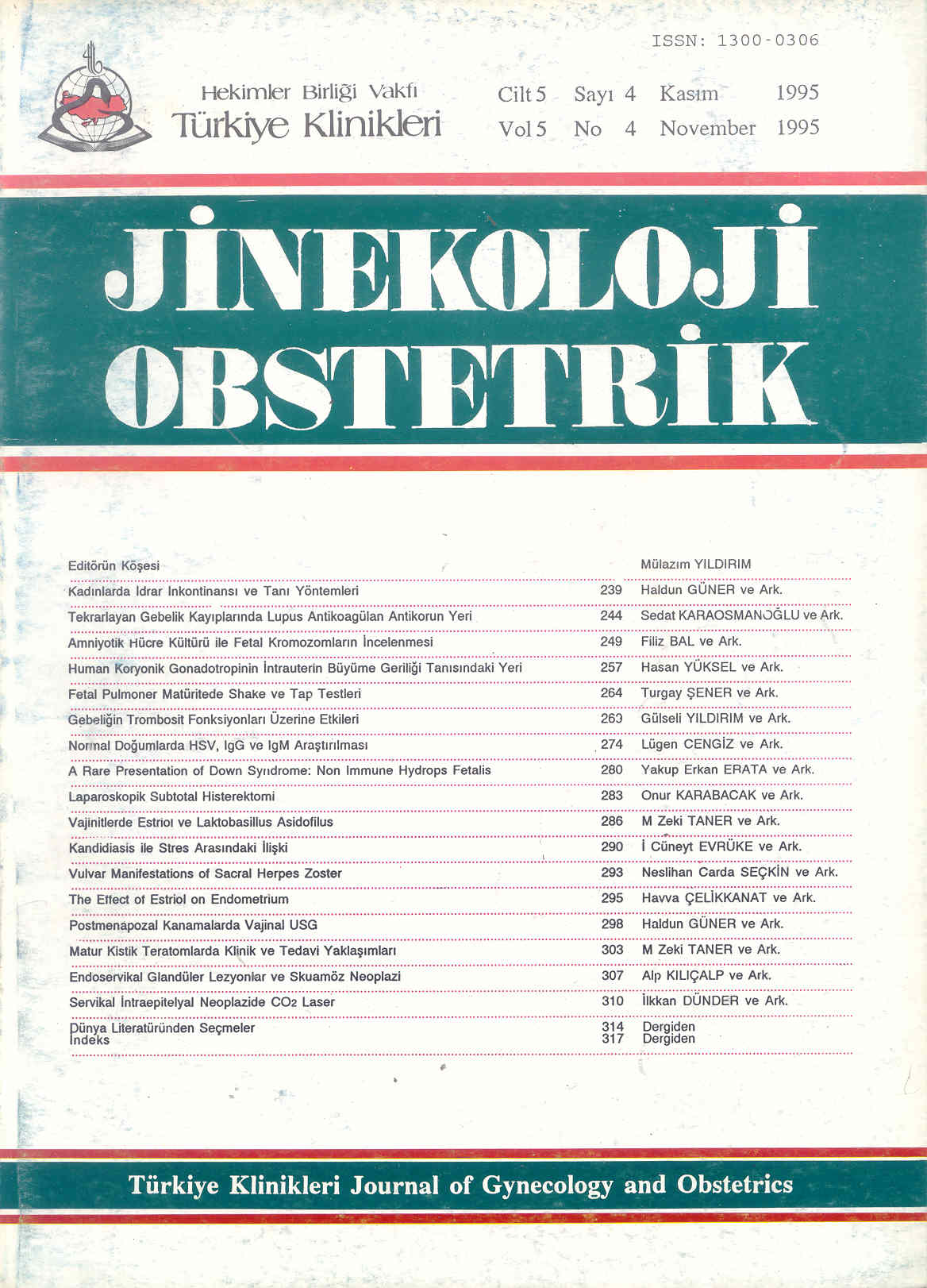Open Access
Peer Reviewed
ARTICLES
3505 Viewed1084 Downloaded
Endometrial Assessment By Vaginal Ultrasonography Might Reduce Endometrial Sampling In Patients With Postmenopausal Bleeding
Postmenapozal Kanamalı Hastalarda, Vajinal Ultrasonografi ile Endometrial Değerlendirme Diagnostik Kürtajları Azaltabilir mi?
Turkiye Klinikleri J Gynecol Obst. 1995;5(4):298-302
Article Language: TR
Copyright Ⓒ 2025 by Türkiye Klinikleri. This is an open access article under the CC BY-NC-ND license (http://creativecommons.org/licenses/by-nc-nd/4.0/)
ÖZET
Amaç: Postmenapozal hastalarda transvaginal ultrasonografik endometrial değerlendirme ile, endometrial küretajda elde edilen doku histolojisini karşılaştırmak ve postmenapozal kanamalı olgularda gereksiz tanısal küretaj sayısını azaltmak için endometrial kalınlık yönünden bir sınır değer saptamak. Çalışmanın Yapıldığı Yer: Gazi Üniversitesi Tıp Fakültesi Kadın Hastalıkları ve Doğum AD, Beşevler, Ankara. Materyel ve Metod: Total olarak 289 postmenapozal kadın prospektif olarak çalışmaya alındı. 192 postmenapozal kanamalı ve 97 kanaması olmayan hasta çalışma ve kontrol gruplarını oluşturdu. Tüm hastalara transvajinal USG yapıldı, daha sonra endometrial değerlendirme için dilatasyon ve küretaj uygulandı. Bulgular: Postmenapozal kanaması olan veya olmayan tüm kadınlarda sonografik olarak 4 mm ve daha az endometrial kalınlık, endometrial histopatolojide "Atrofik endometrium" olarak bulundu. Her 2 grupta endometriumu 4 mm'den kalın olan 158 kadından 40'ı (%25.1) histopatolojik negatif (-) (tanı için yetersiz doku veya atrofik endometrium) bulunurken, 118 hasta (%74.8) proliferatif ve sekretuar endometrium, endometrial hiperplazi, polip ve kanseri içine alan histopatolojik pozitif (+) sonuç bulunmuştur. Sonuç: 4 mm ve altındaki endometrial kalınlık; postmenapozal kanaması olan ya da olmayan hastalarda, endometrial patoloji bulunmayan olguları %100 doğrulukla tahmin etmektedir (eşlik değer). Endometrial kalınlık artıkça, yapılacak küretajlarda endometrial bir patoloji bulma olasılığı lineer olarak artmaktadır (Pozitif prediktif değer %74.6).
Amaç: Postmenapozal hastalarda transvaginal ultrasonografik endometrial değerlendirme ile, endometrial küretajda elde edilen doku histolojisini karşılaştırmak ve postmenapozal kanamalı olgularda gereksiz tanısal küretaj sayısını azaltmak için endometrial kalınlık yönünden bir sınır değer saptamak. Çalışmanın Yapıldığı Yer: Gazi Üniversitesi Tıp Fakültesi Kadın Hastalıkları ve Doğum AD, Beşevler, Ankara. Materyel ve Metod: Total olarak 289 postmenapozal kadın prospektif olarak çalışmaya alındı. 192 postmenapozal kanamalı ve 97 kanaması olmayan hasta çalışma ve kontrol gruplarını oluşturdu. Tüm hastalara transvajinal USG yapıldı, daha sonra endometrial değerlendirme için dilatasyon ve küretaj uygulandı. Bulgular: Postmenapozal kanaması olan veya olmayan tüm kadınlarda sonografik olarak 4 mm ve daha az endometrial kalınlık, endometrial histopatolojide "Atrofik endometrium" olarak bulundu. Her 2 grupta endometriumu 4 mm'den kalın olan 158 kadından 40'ı (%25.1) histopatolojik negatif (-) (tanı için yetersiz doku veya atrofik endometrium) bulunurken, 118 hasta (%74.8) proliferatif ve sekretuar endometrium, endometrial hiperplazi, polip ve kanseri içine alan histopatolojik pozitif (+) sonuç bulunmuştur. Sonuç: 4 mm ve altındaki endometrial kalınlık; postmenapozal kanaması olan ya da olmayan hastalarda, endometrial patoloji bulunmayan olguları %100 doğrulukla tahmin etmektedir (eşlik değer). Endometrial kalınlık artıkça, yapılacak küretajlarda endometrial bir patoloji bulma olasılığı lineer olarak artmaktadır (Pozitif prediktif değer %74.6).
ANAHTAR KELİMELER: Transvaginal USG, postmenapozal kanama, dilatasyon ve küretaj
ABSTRACT
Objective: To compare transvaginal sonographic endometrial assessment with histology obtained by endometrial curettage in postmenopausal patients and to determine a cut-off point for endometrial thickness to reduce unnecessary diagnostic curettages in postmenopausal bleeding. Institution: Gazi University Medical Faculty, Department of Obstetrics and Gynecology, Beşevler, Ankara. Material and Methods: A total number of 289 postmenopausal women were studied prospectively. 192 patient with postmenopausal bleeding and 97 postmenopausal women without bleeding were consisted of study and control groups respectively. All patients were scanned by ultrasound transvaginal, then dilatation & curettage is performed for endometrial evaluation. Results: In all women with and without postmenopausal bleeding, endometrial thickness of 4 mm or less as depicted by sonography correlated well with "atrophic endometrium" (100%). Of 158 women with an endometrium < 4 mm in both groups, 40 women (25.1%) had a negative result (tissue insufficient for diagnosis or atrophic endometrium) while 118 patients (74.8%) had a positive result which included proliferative and secretory endometrium, endometrial hyperplasia, polyps and cancer. Conclusion: Endometrial thickness of ≤ 4 mm may serve as cut-off point for predicting pathology negative cases with accuracy of 100% in postmenopausal bleeding positive and negative cases. Then as the endometrial thickness increase the probability of finding endometrial pathology in curettage increase linearly with positive predictive value of 74.6%.
Objective: To compare transvaginal sonographic endometrial assessment with histology obtained by endometrial curettage in postmenopausal patients and to determine a cut-off point for endometrial thickness to reduce unnecessary diagnostic curettages in postmenopausal bleeding. Institution: Gazi University Medical Faculty, Department of Obstetrics and Gynecology, Beşevler, Ankara. Material and Methods: A total number of 289 postmenopausal women were studied prospectively. 192 patient with postmenopausal bleeding and 97 postmenopausal women without bleeding were consisted of study and control groups respectively. All patients were scanned by ultrasound transvaginal, then dilatation & curettage is performed for endometrial evaluation. Results: In all women with and without postmenopausal bleeding, endometrial thickness of 4 mm or less as depicted by sonography correlated well with "atrophic endometrium" (100%). Of 158 women with an endometrium < 4 mm in both groups, 40 women (25.1%) had a negative result (tissue insufficient for diagnosis or atrophic endometrium) while 118 patients (74.8%) had a positive result which included proliferative and secretory endometrium, endometrial hyperplasia, polyps and cancer. Conclusion: Endometrial thickness of ≤ 4 mm may serve as cut-off point for predicting pathology negative cases with accuracy of 100% in postmenopausal bleeding positive and negative cases. Then as the endometrial thickness increase the probability of finding endometrial pathology in curettage increase linearly with positive predictive value of 74.6%.
MENU
POPULAR ARTICLES
MOST DOWNLOADED ARTICLES





This journal is licensed under a Creative Commons Attribution-NonCommercial-NoDerivatives 4.0 International License.










